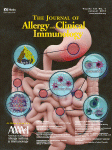 In previous posts I have discussed the progressive emergence of a subset of patients with problems induced by foods driving immune changes in their oesophagus. Eosinophilic oesophagitis (EoE) is a chronic inflammatory disease with isolated eosinophils in the oesophagus predominantly triggered by foods.
In previous posts I have discussed the progressive emergence of a subset of patients with problems induced by foods driving immune changes in their oesophagus. Eosinophilic oesophagitis (EoE) is a chronic inflammatory disease with isolated eosinophils in the oesophagus predominantly triggered by foods.
Eosinophilic esophagitis (EoE) is characterised by an isolated infiltration of the oesophagus with eosinophil’s without infiltration in other parts of the gastrointestinal tract. The symptoms of EoE are similar to those of gastrointestinal reflux disease and include vomiting, abdominal pain, regurgitation, and dysphagia. The number of oesophageal eosinophils per high-power field (hpf) is required as part of the clinicopathologic diagnosis, which is defined as 15 or more eosinophils per hpf in a patient receiving a proton pump inhibitor.
Although it is now accepted that foods are major antigenic triggers for EoE in children, the optimal method for identifying foods is unclear. Unfortunately, dietary restriction based on skin prick tests (SPTs) alone might only benefit a very select group of patients.
In this trial a strict elemental diet was used in less than 5% of patients, with improvement in biopsy results in upward of 98%.[1] One hundred sixty-five (17.5%) patients from the original 941 cohorts received at least 50% of their calories from elemental formulas (along with limited foods) for the diet treatment. The population was younger (2.8 years) than the general EoE population (6.4 years), possibly because of compliance issues with the elemental diet in older patients. Many of these patients (13% of the entire EoE cohort) reacted to some fruits and vegetables, and dietary advancement was difficult.
The chart below shows the most common food groups that caused an aggravation or induction of their primary symptoms.
EoE and IgE-mediated foods identified in patients with EoE
|
|
EoE foods by biopsy (n = 602) |
EoE foods by symptoms (n = 726) |
IgE-mediated foods (n = 269) |
Combined (n = 1597) |
| Milk | 211 (35%) | 139 (19%) | 27 (10%) | 377 (24%) |
| Egg | 78 (13%) | 81 (11%) | 47 (17%) | 206 (13%) |
| Wheat | 72 (12%) | 65 (9%) | 2 (<1%) | 139 (9%) |
| Soy | 52 (9%) | 75 (10%) | 10 (4%) | 137 (9%) |
| Peanut | 16 (3%) | 37 (5%) | 58 (22%) | 111 (7%) |
| Beef | 33 (5%) | 59 (8%) | 1 (<1%) | 93 (6%) |
| Corn | 39 (6%) | 51 (7%) | 0 (<1%) | 90 (6%) |
| Chicken | 32 (5%) | 52 (7%) | 2 (<1%) | 86 (5%) |
| Potato | 21 (3%) | 34 (5%) | 0 (<1%) | 55 (4%) |
| Pork | 19 (3%) | 29 (4%) | 0 (<1%) | 48 (3%) |
| Rice | 14 (2%) | 29 (4%) | 0 (<1%) | 43 (3%) |
| Other | 15 (2%) | 75 (10%) | 122 (45%) | 212 (13%) |
Foods were identified based on symptoms, changes in oesophageal biopsy specimens, or IgE-mediated reactions. EoE biopsy foods were identified based on changes from normal (0 eosinophils/hpf) to abnormal (>15 eosinophils/hpf) values or vice versa. The average eosinophil count on reintroduction was 49 eosinophils/hpf.
EoE food symptoms were based on foods causing symptoms per parental report that did not continue in the diet. IgE-mediated foods were foods that caused urticaria or anaphylaxis on food exposure. Percentages represent the percentage of each food per total number of foods per column.
Because of the high incidence of milk, egg, and meats as a common foods causing EoE, the researchers examined the use of a vegan diet in treating patients with EoE. They proposed that this diet might be easier and more socially acceptable. They found a similar success rate of 48% for removal of milk, egg, and wheat in patients with EoE.
Clinical implications
An empiric elimination diet is equivalent to the use of allergy testing–directed diets for the treatment of EoE.
References
[1] Spergel JM, Brown-Whitehorn TF, Cianferoni A, Shuker M, Wang ML, Verma R, Liacouras CA. Identification of causative foods in children with eosinophilic esophagitis treated with an elimination diet. J Allergy Clin Immunol. 2012 Aug;130(2):461-7.e5. doi: 10.1016/j.jaci.2012.05.021. Epub 2012 Jun 27. View Abstract





